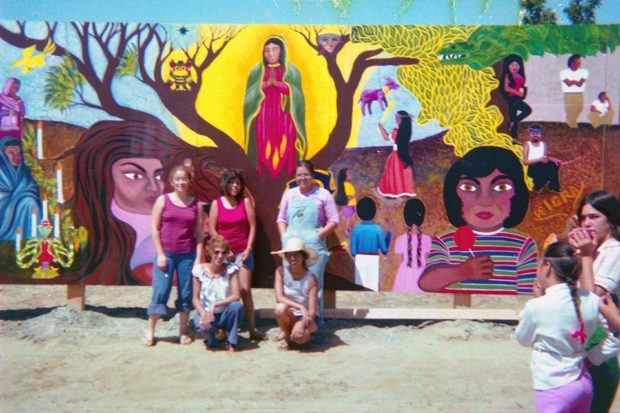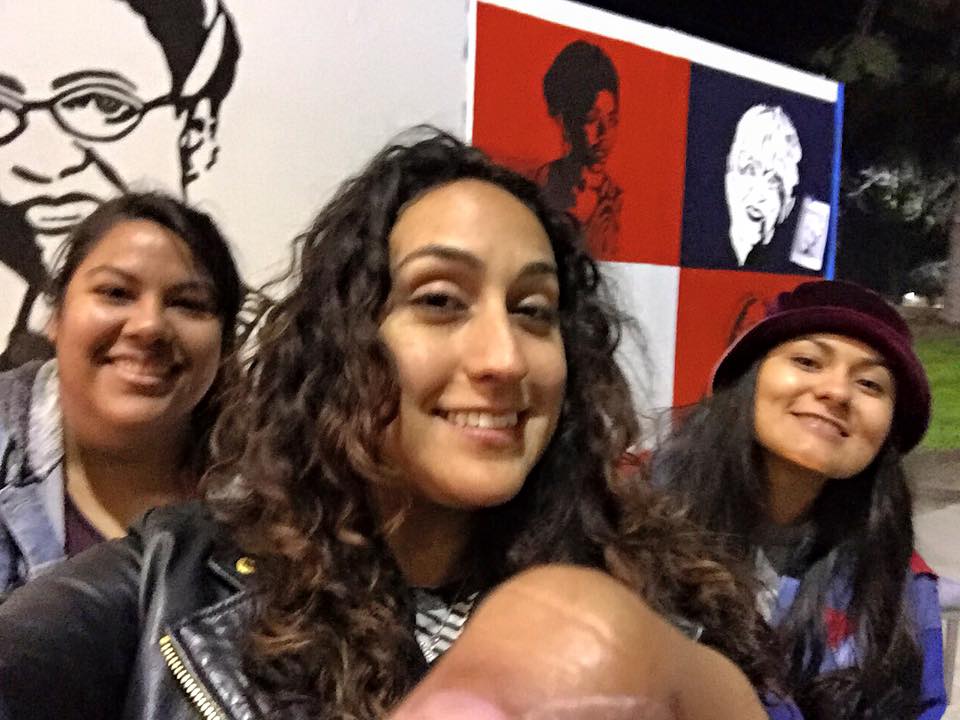
A discussion with Teresa Flores and Carissa Garcia
By Hannah Brandt
On March 17, Fresno State students engaged in a film presentation, discussion, and workshop on the history of art in the Central Valley. The description of the event said, “Chicana filmmakers, authors, and artists Carissa Garcia, Teresa Flores, Cecilia Aranaydo, and Silvia Garcia, join us to celebrate their soon to be released photo book on the murals of Fresno County. Workshop participants will have opportunities to remythologize iconic images and local stories of women in the backdrop of the politics of the Central Valley landscape.”
Garcia and Flores talked about their upcoming book, facilitated a discussion on the documentary film about Chicana artists from the Central Valley in the 1970’s, and then students worked in groups to share their own stories and create poster murals. Afterward, I spoke to the women behind the projects. Teresa Flores got her Masters in Fine Art (MFA) in Public Practice at Otis College of Art and Design in Los Angeles and a BA in Fine Art from Fresno State. She now lives in L.A. where she is an artist and educator working on various community projects. Carissa Garcia is working on her PhD. in Chicano Studies at UCLA, where she also studied Expressive Arts.
The idea for the photo book on Fresno murals was born from Creative Fresno’s digital mural mapping project, a crowdsourced, interactive map that makes the art accessible and navigable to the public. Anyone with a smartphone can upload photos of neighborhood art, such as murals, graffiti or painted signs into the map. So far there are 250 murals from throughout Fresno County, most of them are in the City of Fresno with a few in Clovis and rural areas.
Faced with the scope of the material for the map, Flores says she and her partners at Creative Fresno realized “how much history and significance to the community” these murals held. That is when they decided to create the book and bring in a researcher, Carissa Garcia. “While the book focuses on photos, it also traces the history of muralism in Fresno.” As a second generation Chicana artist, Garcia also wants to pay tribute to the artists of her mothers’ generation. She told students, “If we don’t tell our story, that’s erasure.”
That is where Cecilia Aranaydo and Silvia Garcia (Carissa’s mother) come in. One of the images in the book is Las Mujeres Muralistas del Valle (The Women Muralists of the Valley) from 1978. It depicts five Chicana artists standing in front of their completed mural: Silvia Garcia, Cecilia Aranaydo, Lupe Gonzalez, Ernestine Silva, Helen Gonzalez. Two young girls watch the women from the side of the photo. These women were also profiled in the documentary film. They had taken a stand against participating in white feminist art projects, including one who refused to go to New York City when she was asked to assist Judy Chicago in a major project. That 1979 art installation would be credited as the first epic feminist artwork, The Last Supper (The Dinner Party) but it did not include women of color. Garcia explained, “We want to have a seat at the table, but not be diminished.”
When debriefing the film with students, Flores and Garcia said that Central Valley artists have always been diminished by the larger art community in California, nationally and internationally. Garcia assured the students that “while our art is different than that of Los Angeles and San Francisco, it is not lesser.” Additionally, Chicano and female artists too often have not been valued or treated as secondary to white men. She also said, “Fresno’s white community tends to be politically conservative and muralism as an artistic movement was created by communities of color.”
Flores was also an instructor in the Department of Art and Design at Fresno State. She discussed the history of the Feminist Art Program, which was active at the university in the 1970’s and 1980’s. It was created to have more representation of women in art. During her time teaching at CSUF, The Rad Fresno State Women project was launched to commemorate local women who made radical change in their communities, including two art teachers at CSUF. With Creative Fresno, Flores and members of the community created the Mobile Mural Project. “The mobile murals are still in existence but the sites for painting were temporary. They were temporary “pop-up” painting zones where the community in the area that day painted their memories.”

In Fall of 2015, Flores and her students mounted temporary murals on campus walls at Fresno State. It was a collaboration between students from Visual Culture, Women’s Studies, and the Education Department. One of the descriptions read “We are painting this mural to honor the memory of Dr. Paulette Flemming and her commitment to art education at Fresno State and to honor the 12 Rad Women of the Rad Fresno State Women project.” Images were carved into wood and then printed onto poster-sized paper, which was adhered to surfaces with a washable paste. The university was supportive of the project but could only allow the project if the art was taken down after two weeks, removing all traces. That was not to be their end, however. The Fresno Art Museum created an exhibit of the Rad Women images.
“This mural mapping and photo book project is about building local infrastructure to get funding and build long-term institutions,” Flores said. “It is important to make sure artists are recognized for their contribution to the community, are compensated for their labor, and are paid what they are worth.” The project had to set up a Kickstarter campaign to ensure Garcia was paid for her tireless work. Flores says that she brings her knowledge from studying Public Practice to challenge her students to “expand their idea about space and who makes art.”
The oldest mural in Fresno is at St. John’s Cathedral and was done by an Italian artist named Luigi Brusatori in 1915. The second oldest is called Grape Harvest and was made by Henry Varnum Poor as part of the Works Progress Administration (WPA) in 1942. It is a ceramic glaze mural on the main post office in downtown Fresno. As for contemporary works, Flores says “on the surface, it looks like Fresno murals are apolitical but if you look closer you see more is going on.” Most are labeled Pop-Surrealism or Magical Realism, and Flores believes the genres fit with the neo-muralism that is happening on the U.S.-Mexico border.
Flores says “It’s cool to watch Fresno art grow and get more funding. The creative economy here has always been really poor. Getting money for this project is important because it doesn’t happen a lot in Fresno. The Digital Mapping Project and the photo book focus on the politics of space in the region, who participates in art, in public art, the way murals are produced and who is producing them.” Look for Creative Fresno’s Digital Mural Map at http://map.creativefresno.com and stay tuned for the mural photo book to be published by Fresno State press this summer, http://www.thepressatcsufresno.org/.
*****
Hannah Brandt is the editor of Community Alliance newspaper. You can follow her on Twitter and Instagram at @HannahBP2. Follow the paper on Facebook at Community Alliance Newspaper and on Twitter and Instagram @fresnoalliance.
